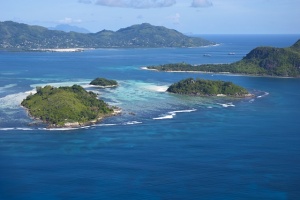Proposed bill seeks to ensure more protected areas in Seychelles
Conservation |Author: Sharon Ernesta | February 15, 2019, Friday @ 10:09| 14308 views
One of the oldest marine reserves in Seychelles is Ste Anne marine park declared in 1973. (Gerard Larose, Seychelles Tourism Board)
(Seychelles News Agency) - A new bill to replace the National Parks and Nature Conservancy Act is being proposed in Seychelles to ensure more protected areas in the island nation.
The Ministry of Environment, Energy and Climate Change has started the consultative process to replace the existing legislation with a new Nature Reserves and Conservancy bill which has been in the making for the past six years.
“The Nature Reserve and Conservancy bill is the piece of legislation that will be used to designate, classify and manage protected areas of the island nation. It is expected to be accompanied by a number of subsidiary legislation that will eventually also come into force under this new law,” explained the senior legal officer of the Ministry.
Sharon Gerry told SNA the National Parks and Nature Conservancy Act of 1969 provides matters related to protected areas and conservation of biological diversity.
“However, the Act is quite dated, does not reflect international best practices and does not align with the various protected areas provided by the International Union for Conservation of Nature (IUCN) which is also reflected in our Protected Area Policy of 2013. Therefore, we had to review the existing Act with the assistance of our various local stakeholders and in close consultation with the Department of Legal Affairs,” explained Gerry.
Currently, the proposed Nature Reserves and Conservancy Bill is going through the “White Paper Stage” whereby the proposed legislation is being presented to the general public for their final comments and suggestions.
A series of public meetings have been held on the three main islands of Mahe, Praslin and La Digue. Marie May Muzungaile, the director general in the biodiversity conservation and management division, said that the ministry received a lot of valuable comments.
“We received a lot of feedback. Some of the feedbacks will be simple enough to amend in the bill while others will deserve more legal consultations with the office of the Attorney General.”
The director general further added that once everything is sorted and there is an updated version of the bill, it will be brought to the Cabinet of Ministers in order to be endorsed and then to the National Assembly for approval.
However if the feedback collected from the public consultations brings about major amendments to the bill, the ministry will have to bring it back to the public, meaning the timeline for the bill’s passage is hard to predict.
But what will that mean in terms of protection of biodiversity for the island nation renowned as a world leader and champion of environment conservation?
“The proposed legislation will provide for a more modern and holistic approach towards biological diversity protection. Modern in the sense that new categories of protected areas will be introduced which is in line with international norms and best practices and holistic in the sense that now, everyone will have an active role to play towards biological diversity protection; from the Ministry to the persons managing these protected areas, to normal citizens,” explained Gerry.
Seychelles – a group of 115 islands in the western Indian Ocean -- has over 20 land and marine parks, these include islands as well as special reserves. The legal officer explained that will new bill will also redefine the sizes of these.
“This will depend and vary, based on the various characteristics of areas that will be subject to the designation process and the relevant categories under which they will be designated. However, the end goal is to have more protected areas,” concluded Gerry.
Once the Nature Reserve and Conservancy bill is approved and becomes law, it will become a major tool for the Ministry of Environment, Energy and Climate Change which will allow it to improve on some current practices and reinforce conservation.
Back
